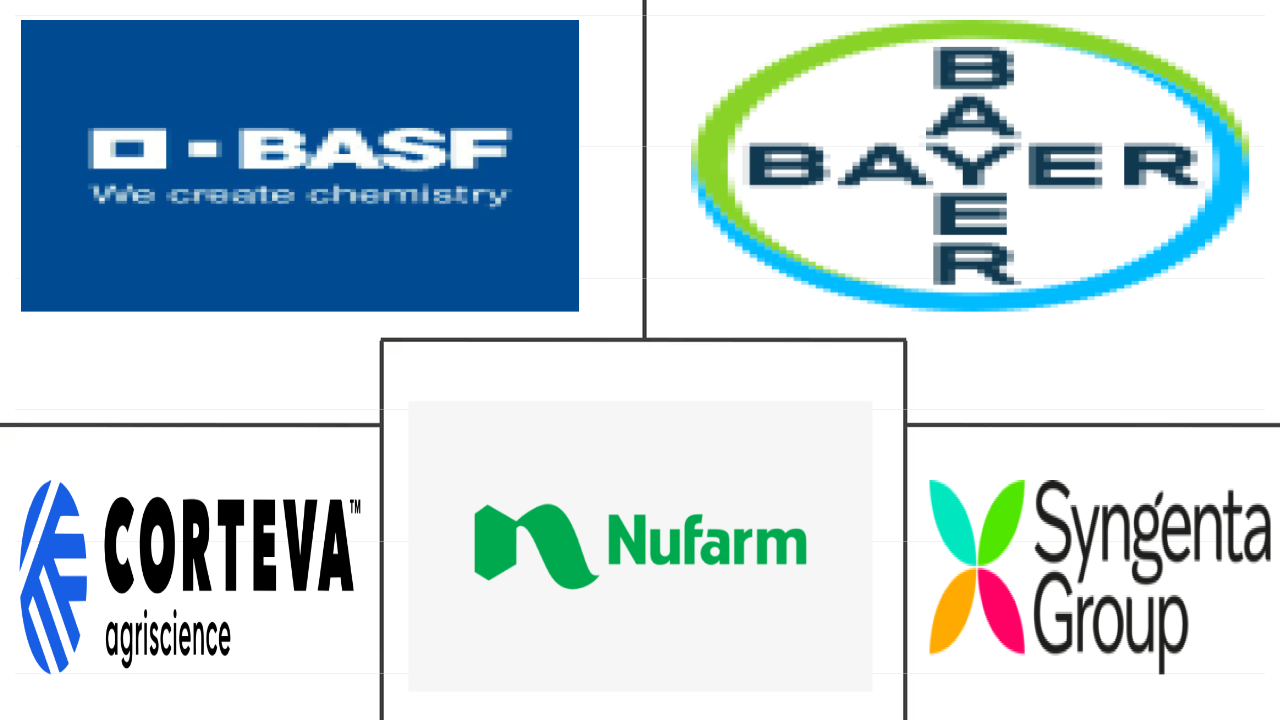Market Size of us herbicide Industry
| Icons | Lable | Value |
|---|---|---|
|
|
Study Period | 2017 - 2029 |
|
|
Market Size (2024) | USD 10.93 Billion |
|
|
Market Size (2029) | USD 13.95 Billion |
|
|
Largest Share by Application Mode | Soil Treatment |
|
|
CAGR (2024 - 2029) | 5.01 % |
|
|
Fastest Growing by Application Mode | Soil Treatment |
|
|
Market Concentration | Medium |
Major Players |
||

|
||
|
*Disclaimer: Major Players sorted in no particular order |
US Herbicide Market Analysis
The US Herbicide Market size is estimated at 10.93 billion USD in 2024, and is expected to reach 13.95 billion USD by 2029, growing at a CAGR of 5.01% during the forecast period (2024-2029).
10.93 Billion
Market Size in 2024 (USD)
13.95 Billion
Market Size in 2029 (USD)
8.52 %
CAGR (2017-2023)
5.01 %
CAGR (2024-2029)
Largest Segment by Application Mode
49.24 %
value share, Soil Treatment, 2023
Soil application of herbicides is regarded as the simplest, safest, and most efficient way of weed control, proving to be the most economical in many instances.
Largest Segment by Crop Type
44.77 %
value share, Grains & Cereals, 2023
Grains and cereals dominance is due to the challenges from various weeds like wild mustard, wild oats, quack grass, and others, which can significantly impact crop yields.
Fastest-Growing Segment by Crop Type
5.21 %
Projected CAGR, Grains & Cereals, 2024-2029
Grains and cereals dominance is due to the challenges from various weeds like wild mustard, wild oats, quack grass, and others, which can significantly impact crop yields.
Leading Market Player 1
17.28 %
market share, Bayer AG, 2022

Bayer has partnered with Oerth Bio with an aim to develop next-generation crop protection products based on Oerth Bio's innovative protein degradation technology.
Leading Market Player 2
10.17 %
market share, Syngenta Group, 2022

The company invests more than USD 1.3 billion per year in global R&D to develop advanced, innovative technologies and products to address farmers' crop protection challenges.
In the United States, soil treatment holds the utmost importance as the primary mode of herbicide application
- In the United States, various modes of herbicide application are employed to efficiently manage weeds in agriculture. By selecting appropriate application methods, farmers can achieve cost-effective solutions, ensuring precise coverage of targeted areas and minimizing wastage. This enhanced efficiency optimizes herbicide usage, ultimately leading to reduced input costs for farmers.
- In agricultural practices, soil application stands out as the predominant mode of herbicide usage, which represented 49.1% of the total herbicide application segment in 2022. This method is majorly employed in the cultivation of grains and cereals, which holds the largest market share at 44.7%. The preference for soil treatment herbicides is driven by their efficacy in protecting the quality of grains and cereals by preventing or minimizing weed growth. They are effective in controlling weeds during their pre-emergent and early growth stages.
- Furthermore, the foliar application method secured the second-largest market share by value, which accounted for 29.2% in 2022. This application technique has proven to be advantageous for weed control, particularly in crops that require accurate targeting, for instance, when applied directly onto the leaves of the target plants. This method is effective for controlling above-ground weeds and is commonly used in many agricultural and horticultural settings.
- In the agricultural sector of the United States, herbicide usage is focused on optimizing crop productivity and enhancing overall profitability. The mode of application segment is expected to witness a projected CAGR of 5.0% during the forecast period.
US Herbicide Industry Segmentation
Chemigation, Foliar, Fumigation, Soil Treatment are covered as segments by Application Mode. Commercial Crops, Fruits & Vegetables, Grains & Cereals, Pulses & Oilseeds, Turf & Ornamental are covered as segments by Crop Type.
- In the United States, various modes of herbicide application are employed to efficiently manage weeds in agriculture. By selecting appropriate application methods, farmers can achieve cost-effective solutions, ensuring precise coverage of targeted areas and minimizing wastage. This enhanced efficiency optimizes herbicide usage, ultimately leading to reduced input costs for farmers.
- In agricultural practices, soil application stands out as the predominant mode of herbicide usage, which represented 49.1% of the total herbicide application segment in 2022. This method is majorly employed in the cultivation of grains and cereals, which holds the largest market share at 44.7%. The preference for soil treatment herbicides is driven by their efficacy in protecting the quality of grains and cereals by preventing or minimizing weed growth. They are effective in controlling weeds during their pre-emergent and early growth stages.
- Furthermore, the foliar application method secured the second-largest market share by value, which accounted for 29.2% in 2022. This application technique has proven to be advantageous for weed control, particularly in crops that require accurate targeting, for instance, when applied directly onto the leaves of the target plants. This method is effective for controlling above-ground weeds and is commonly used in many agricultural and horticultural settings.
- In the agricultural sector of the United States, herbicide usage is focused on optimizing crop productivity and enhancing overall profitability. The mode of application segment is expected to witness a projected CAGR of 5.0% during the forecast period.
| Application Mode | |
| Chemigation | |
| Foliar | |
| Fumigation | |
| Soil Treatment |
| Crop Type | |
| Commercial Crops | |
| Fruits & Vegetables | |
| Grains & Cereals | |
| Pulses & Oilseeds | |
| Turf & Ornamental |
US Herbicide Market Size Summary
The US herbicide market is poised for significant growth, driven by the increasing need for effective weed management in agriculture. Various application methods, such as soil and foliar treatments, are employed to optimize herbicide usage, ensuring cost-effectiveness and precise targeting. Soil application remains the dominant method, particularly in grain and cereal cultivation, due to its efficacy in controlling weeds during critical growth stages. The foliar application method also holds a substantial market share, offering targeted control of above-ground weeds. The adoption of herbicide-tolerant genetically modified crops has further propelled herbicide consumption, allowing for direct application without harming the crops. This trend, coupled with the expansion of intensive farming practices, underscores the growing reliance on herbicides to maximize crop yields and meet the increasing food demand.
The market landscape is moderately consolidated, with major players like BASF SE, Bayer AG, Corteva Agriscience, Nufarm Ltd, and Syngenta Group dominating the scene. These companies are actively innovating and expanding their product portfolios to address challenges such as weed resistance and to enhance crop protection technologies. Regulatory changes and the approval of new pesticide formulations also play a crucial role in shaping herbicide consumption patterns. Commonly used herbicides like atrazine, paraquat, and glyphosate are integral to managing weed infestations, which pose significant challenges to agricultural productivity. As the market evolves, these factors collectively contribute to the anticipated growth trajectory of the US herbicide market over the forecast period.
US Herbicide Market Size - Table of Contents
-
1. MARKET SEGMENTATION (includes market size in Value in USD and Volume, Forecasts up to 2029 and analysis of growth prospects)
-
1.1 Application Mode
-
1.1.1 Chemigation
-
1.1.2 Foliar
-
1.1.3 Fumigation
-
1.1.4 Soil Treatment
-
-
1.2 Crop Type
-
1.2.1 Commercial Crops
-
1.2.2 Fruits & Vegetables
-
1.2.3 Grains & Cereals
-
1.2.4 Pulses & Oilseeds
-
1.2.5 Turf & Ornamental
-
-
US Herbicide Market Size FAQs
How big is the US Herbicide Market?
The US Herbicide Market size is expected to reach USD 10.93 billion in 2024 and grow at a CAGR of 5.01% to reach USD 13.95 billion by 2029.
What is the current US Herbicide Market size?
In 2024, the US Herbicide Market size is expected to reach USD 10.93 billion.

